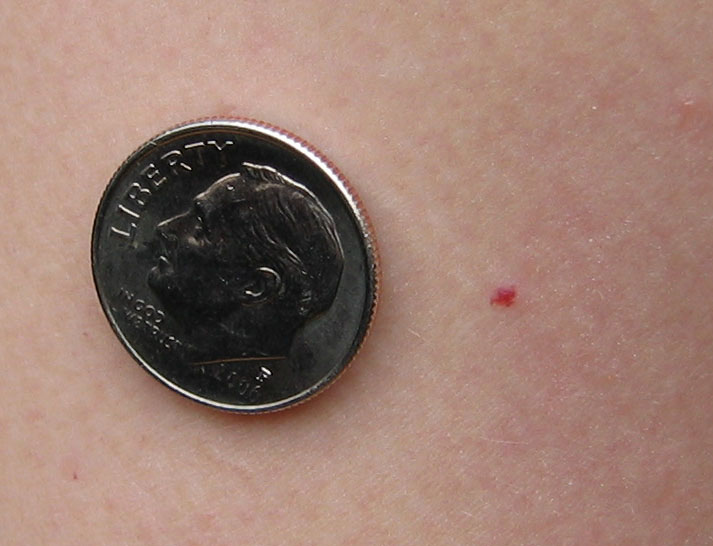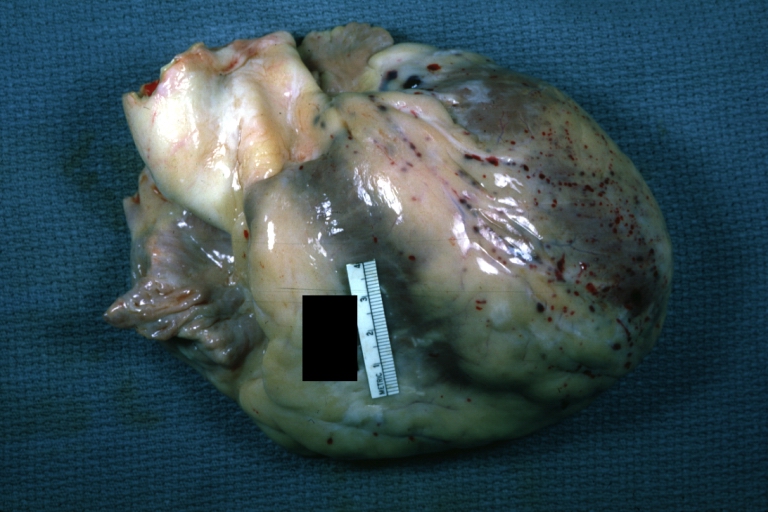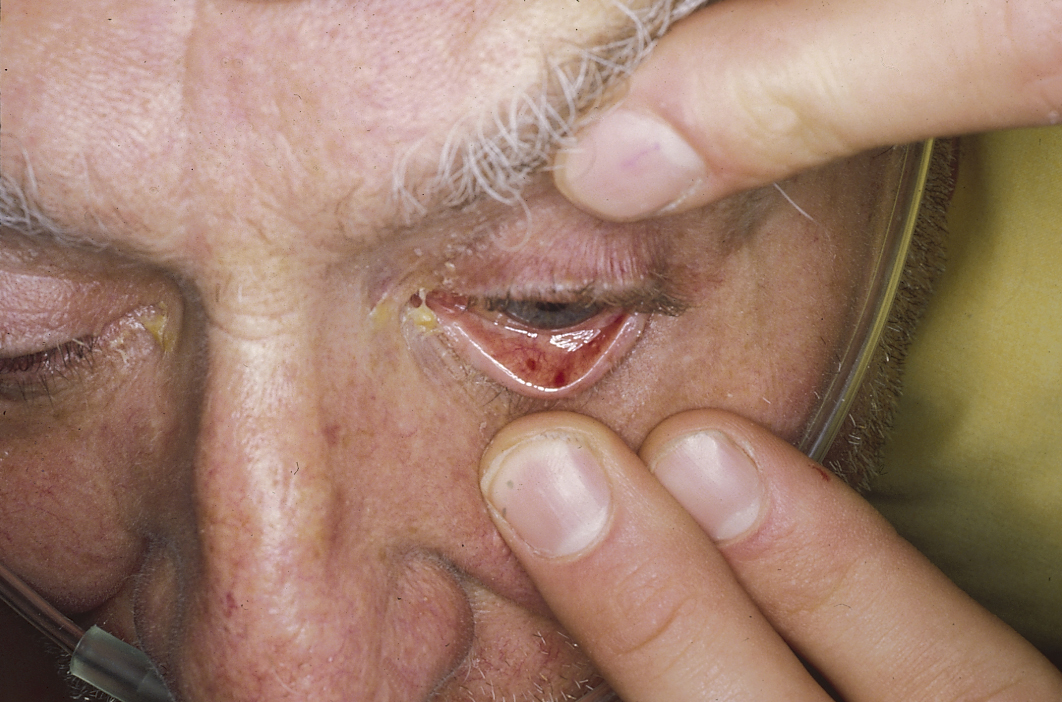Petechia: Difference between revisions
m (Robot: Automated text replacement (-{{SIB}} +, -{{EH}} +, -{{EJ}} +, -{{Editor Help}} +, -{{Editor Join}} +)) |
No edit summary |
||
| Line 1: | Line 1: | ||
__NOTOC__ | |||
{{Infobox_Disease | | {{Infobox_Disease | | ||
Name = Petechia | | Name = Petechia | | ||
| Line 4: | Line 5: | ||
Caption = A minor petechia. | | Caption = A minor petechia. | | ||
ICD10 = {{ICD10|R|23|3|r|20}} | | ICD10 = {{ICD10|R|23|3|r|20}} | | ||
ICD9 = {{ICD9|782.7}} | | |||
}} | }} | ||
{{SI}} | {{SI}} | ||
{{CMG}} | {{CMG}} | ||
==Overview== | |||
A '''petechia''' ({{pronounced|pɨˈtiːkiə}}), plural '''petechiae''' ({{IPA|pɨˈtiːkɪiː}}) is a small red or purple spot on the body, caused by a minor [[hemorrhage]] (broken [[capillary]] [[blood vessel]]s). | |||
== Pathophysiology== | |||
Petechiae may be a sign of [[thrombocytopenia]] (low [[platelet]] counts). They also occur in circumstances when platelet function is inhibited (e.g., as a side effect of medications or during certain infections) or when excessive pressure is applied to tissue (e.g., when a tourniquet is applied to an extremity or with excessive coughing). | |||
Petechiae should always be quickly investigated. They can be interpreted as [[vasculitis]], an inflammation of the blood vessels, which requires immediate treatment to prevent permanent damage. Some malignancies can also cause petechiae to appear. Petechiae should be investigated by a physician immediately to rule out the more dangerous conditions. Dermatologists can be the most helpful specialists in these conditions because they can more easily identify if the condition is petechiae or some similar looking but less worrisome rash. | |||
The significance of petechiae in children depends on the clinical context in which they arise. Petechiae in children can occur with viral infections. In this setting they do not necessarily signify serious illness. They are the hallmark of some possibly serious illnesses, however, such as [[meningococcemia]], various causes of [[thrombocytopenia]], and [[leukemia]]. Therefore, their presence should not be ignored. | |||
== | ===Gross Pathology=== | ||
<div align="left"> | |||
<gallery heights="175" widths="175"> | |||
Image:Petechiae heart 001.jpg|Epicardial petechiae: Gross, an excellent example of infarct heart with petechiae. <br> <small> [http://www.peir.net Image courtesy of Professor Peter Anderson DVM PhD and published with permission © PEIR, University of Alabama at Birmingham, Department of Pathology] </small> | |||
</gallery> | |||
</div> | |||
===Forensics=== | |||
Petechiae on the face and [[conjunctiva]] (eyes) are a sign of a death by [[asphyxia]]tion. They are thought to result from an increase of pressure in the [[vein]]s of the head and [[Hypoxia (medical)|hypoxic]] damage to [[endothelium|endothelial]] of blood vessels.<ref>{{cite journal |last= Ely |first= Susan F. |coauthors= Charles S. Hirsch |title= Ashpyxial deaths and petechiae: a review |url= http://www.charlydmiller.com/LIB04/2000petechiaereview.pdf |format= PDF |journal= Journal of Forensic Science |volume= 45 |issue= 6 |date= 2000 |pages=1274-1277 |accessdate= 2007-09-22 }}</ref> | |||
==Causes== | |||
== | ===Causes in Alphabetical Order=== | ||
* [[Bolivian hemorrhagic fever]] | * [[Bolivian hemorrhagic fever]] | ||
* [[Boutonneuse fever]] | * [[Boutonneuse fever]] | ||
* Childhood protein-energy malnutrition such as [[Kwashiorkor]] or [[Marasmus]] | |||
* [[Congenital syphilis]] | |||
* [[Crimean-Congo hemorrhagic fever]] | * [[Crimean-Congo hemorrhagic fever]] | ||
* [[Dengue fever]] | * [[Dengue fever]] | ||
* [[Duke's disease]] | * [[Duke's disease]] | ||
| Line 26: | Line 45: | ||
* [[Gua Sha]] | * [[Gua Sha]] | ||
* [[Henoch-Schönlein purpura]] | * [[Henoch-Schönlein purpura]] | ||
* [[Kawasaki disease]] | |||
* [[Kawasaki fever]] | |||
* [[Leukemia]] | * [[Leukemia]] | ||
* | * [[Rocky mountain spotted fever]] | ||
* [[Scarlet Fever]] | * [[Scarlet Fever]] | ||
* [[Schamberg's Disease]] | * [[Schamberg's Disease]] | ||
* [[ | * [[Typhus]] <ref>{{cite web |url=http://www.nlm.nih.gov/medlineplus/ency/article/001363.htm |title=Typhus |accessdate=2007-11-05 |author=Grayson MD, Charlotte |date=2006-09-26 |work=[[MedlinePlus|MedlinePlus Medical Encyclopedia]] |publisher=[[National Institutes of Health]]}}</ref> | ||
==Physical examination== | ==Physical examination== | ||
| Line 45: | Line 57: | ||
<gallery heights="175" widths="175"> | <gallery heights="175" widths="175"> | ||
Image:eye_petechiae.jpg|Conjunctival Petechiae: Conjunctival petechiae, in this case secondary to endocarditis. (Image courtesy of Josh Fierer, M.D and Charlie Goldberg, M.D.) | Image:eye_petechiae.jpg|Conjunctival Petechiae: Conjunctival petechiae, in this case secondary to endocarditis. (Image courtesy of Josh Fierer, M.D and Charlie Goldberg, M.D.) | ||
</gallery> | </gallery> | ||
</div> | </div> | ||
==References== | ==References== | ||
{{reflist}} | {{reflist}} | ||
[[Category:Signs and symptoms]] | [[Category:Signs and symptoms]] | ||
| Line 72: | Line 69: | ||
[[Category:Intensive care medicine]] | [[Category:Intensive care medicine]] | ||
[[Category:Primary care]] | [[Category:Primary care]] | ||
[[Category:Signs and symptoms]] | |||
{{WikiDoc Help Menu}} | {{WikiDoc Help Menu}} | ||
{{WikiDoc Sources}} | {{WikiDoc Sources}} | ||
Revision as of 01:33, 26 August 2012
| Petechia | |
 | |
|---|---|
| A minor petechia. | |
| ICD-10 | R23.3 |
| ICD-9 | 782.7 |
|
WikiDoc Resources for Petechia |
|
Articles |
|---|
|
Most recent articles on Petechia |
|
Media |
|
Evidence Based Medicine |
|
Clinical Trials |
|
Ongoing Trials on Petechia at Clinical Trials.gov Clinical Trials on Petechia at Google
|
|
Guidelines / Policies / Govt |
|
US National Guidelines Clearinghouse on Petechia
|
|
Books |
|
News |
|
Commentary |
|
Definitions |
|
Patient Resources / Community |
|
Directions to Hospitals Treating Petechia Risk calculators and risk factors for Petechia
|
|
Healthcare Provider Resources |
|
Causes & Risk Factors for Petechia |
|
Continuing Medical Education (CME) |
|
International |
|
|
|
Business |
|
Experimental / Informatics |
Editor-In-Chief: C. Michael Gibson, M.S., M.D. [1]
Overview
A petechia (Template:Pronounced), plural petechiae (Template:IPA) is a small red or purple spot on the body, caused by a minor hemorrhage (broken capillary blood vessels).
Pathophysiology
Petechiae may be a sign of thrombocytopenia (low platelet counts). They also occur in circumstances when platelet function is inhibited (e.g., as a side effect of medications or during certain infections) or when excessive pressure is applied to tissue (e.g., when a tourniquet is applied to an extremity or with excessive coughing).
Petechiae should always be quickly investigated. They can be interpreted as vasculitis, an inflammation of the blood vessels, which requires immediate treatment to prevent permanent damage. Some malignancies can also cause petechiae to appear. Petechiae should be investigated by a physician immediately to rule out the more dangerous conditions. Dermatologists can be the most helpful specialists in these conditions because they can more easily identify if the condition is petechiae or some similar looking but less worrisome rash.
The significance of petechiae in children depends on the clinical context in which they arise. Petechiae in children can occur with viral infections. In this setting they do not necessarily signify serious illness. They are the hallmark of some possibly serious illnesses, however, such as meningococcemia, various causes of thrombocytopenia, and leukemia. Therefore, their presence should not be ignored.
Gross Pathology
-
Epicardial petechiae: Gross, an excellent example of infarct heart with petechiae.
Image courtesy of Professor Peter Anderson DVM PhD and published with permission © PEIR, University of Alabama at Birmingham, Department of Pathology
Forensics
Petechiae on the face and conjunctiva (eyes) are a sign of a death by asphyxiation. They are thought to result from an increase of pressure in the veins of the head and hypoxic damage to endothelial of blood vessels.[1]
Causes
Causes in Alphabetical Order
- Bolivian hemorrhagic fever
- Boutonneuse fever
- Childhood protein-energy malnutrition such as Kwashiorkor or Marasmus
- Congenital syphilis
- Crimean-Congo hemorrhagic fever
- Dengue fever
- Duke's disease
- Ebola
- Endocarditis
- Erythroblastosis fetalis
- Gua Sha
- Henoch-Schönlein purpura
- Kawasaki disease
- Kawasaki fever
- Leukemia
- Rocky mountain spotted fever
- Scarlet Fever
- Schamberg's Disease
- Typhus [2]
Physical examination
-
Conjunctival Petechiae: Conjunctival petechiae, in this case secondary to endocarditis. (Image courtesy of Josh Fierer, M.D and Charlie Goldberg, M.D.)
References
- ↑ Ely, Susan F. (2000). "Ashpyxial deaths and petechiae: a review" (PDF). Journal of Forensic Science. 45 (6): 1274–1277. Retrieved 2007-09-22. Unknown parameter
|coauthors=ignored (help) - ↑ Grayson MD, Charlotte (2006-09-26). "Typhus". MedlinePlus Medical Encyclopedia. National Institutes of Health. Retrieved 2007-11-05.

